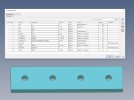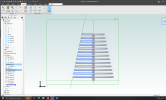Ex Machina
Senior Member
In this video I show how to create pattern where each instance is different and the variance is driven by geometry that can be selected. Any plane, face, surface, etc. can be used to drive the variable pattern. Check it out and let me know what you can do with this little method. Also, let me know if you have found other ways to make variable and adaptable patterns in Alibre.
P.S. Here are the files shown in the video so you can play with them and create your own examples.
P.S. Here are the files shown in the video so you can play with them and create your own examples.
Attachments
Last edited:


